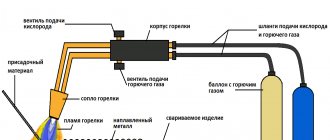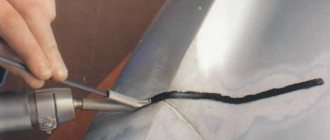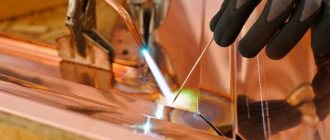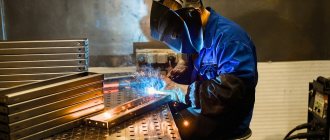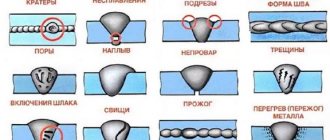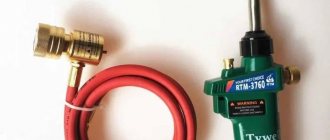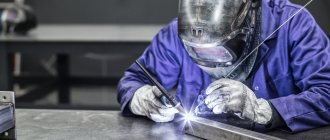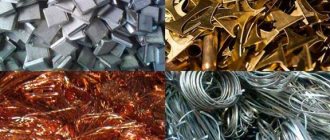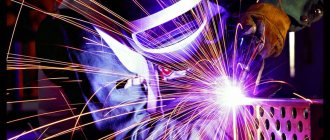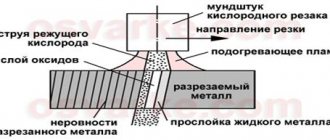Welding is understood as a technological operation (process) to obtain a permanent connection of elements due to the creation of intermolecular/interatomic bonds during general/local heating or plastic deformation (as an option, simultaneous exposure to factors is permissible). Welding is applicable to both metals/alloys and non-metallic materials: ceramics, plastics, and so on.
To supply the required amount of energy to the welding point, different methods can be used: transit of a powerful electric current through the elements being welded (electric contact welding), arc heating (electric arc welding), due to a combustion chemical reaction (gas welding), concentrated radiation/particles (focused electromagnetic radiation welding , laser, electron beam), friction (this also includes ultrasonic welding).
Welding of two elements can be done through diffusion/mixing processes of one kind or another when:
- Heating the material at the desired point until it melts without additional compression of the elements.
- With moderate compression and heating of the elements at the same time.
- With very significant compression of elements without external heating.
Advantages and disadvantages
Before we talk about what soldering is, let's consider the main pros and cons of the technology. The advantages include:
- Ability to connect surfaces with different physical and chemical properties.
- Soldering technology is used to work in hard-to-reach places where welding is impossible.
- There are no requirements for the shape and size of products.
- It is possible to perform processing on all touching planes.
- Soldering does not create internal stress, which has a positive effect on the quality of the metal.
- The relative simplicity of the process, compared to welding, allows you to solder workpieces after obtaining basic knowledge in this area.
Experts identify three shortcomings.
- Low connection strength. This is due to the properties of the materials that are used as solder. Hence the next minus.
- Low heat resistance. You cannot work with parts whose operation is associated with elevated temperatures. For example, sealing a hole in a kettle will definitely not please you with quality and durability.
- Poor performance. For this reason, soldering is practically not used in mass production, and the work performed is associated with point impacts.
Twisting, soldering, welding or terminals - what to choose? Common methods of connecting conductors
How to connect two or more conductive wires to each other is up to everyone to choose for themselves. But do not forget that correct connection and reliable contact between contacting surfaces is the key to safe operation of the electrical network and the almost complete absence of risks of a short circuit, which entails heating of the conductor or fire of the insulation.
In order to correctly connect the wires, you need to remember several important points:
- section,
- material of execution (copper, aluminum, etc.),
- working environment (street, premises, production, etc.),
- set of tools,
- and most importantly - “Rules for Electrical Installations” - a regulatory document that includes general requirements for conductors and their connections. Essential for electricians and electricians.
Differences from welding
It is very difficult for an untrained person to see the difference between welding and soldering, because the connecting seam has practically no visual differences. Meanwhile, the principles of operation of these technologies are radically different. So, what is the difference between welding metal parts and soldering?
The main difference is the effect on the surface . When welding, the workpiece is exposed to an electric arc that occurs when a closed circuit is broken. Under the influence of high temperature, a melt zone is created in which the base metal and flux are mixed. When solidified, a weld seam is formed. When soldering, the connection zone consists exclusively of low-melting solder, without fractions of the main product. The melting point of consumables is not sufficient to change the state of aggregation of the workpieces.
To perform welding work, expensive equipment is required, which depends on the type of welding. In some cases, auxiliary devices are necessary, such as a feed mechanism for semi-automatic machines. The equipment for sealing is simple and low cost. This is the reason for the popularity of soldering when performing restoration repairs at home.
This is how welding differs from soldering. Despite a lot of advantages, the technology in question has not received proper distribution due to low peel strength . For reliable fastening, the parts are joined to the ceiling along a plane.
Lead-free technology
On 27 January 2003, Directive 2002/96/EC of the European Parliament and Council on Waste Electrical and Electronic Equipment (WEEE) came into force. The modern radio-electronic industry is faced with the fact of organizing the collection and disposal of waste containing heavy metals and fire retardants. To successfully solve this problem, one of the necessary conditions is the transition to lead-free technologies for the manufacture of electronic equipment - technologies using materials that do not contain lead.
GOST 17325-79. Soldering and tinning: basic terms and definitions
This interstate standard establishes clear terms and definitions that should be used in technical documentation. It covers all areas of the technologies considered: from general concepts to connection defects.
The alphabetical index of terms has been translated into English and German.
The standard has valid status.
Tinning is a process considered to be a precursor to soldering. After processing, a thin layer of tin forms on the surface.
Where is it used?
Soldering technology takes an honorable second place in terms of frequency of use for joining materials . The championship belongs to welding. However, there are areas where, for certain reasons, it is impossible to use welding equipment and there is no worthy alternative to soldering. The statement is valid for the following industries:
- Production of electronic control boards. Soldering is used to attach miniature components.
- Refrigeration equipment. Copper tubes and heat exchangers are connected only by soldering. Repair of radiators for land transport and special equipment is carried out using this technology.
- Joining high-alloy alloys that are difficult to weld.
- Aviation industry. The intermediate layer of aircraft skin has a honeycomb structure. For its production, soldering is used in thermal furnaces.
The technology is used in cases where other types of connections, such as riveting, gluing or bolting, cannot be used for some reason. An important condition is the absence of requirements for high contact strength.
Definition
Welding is the joining of parts, most often metal, by heating their contacting parts to the point of melting. There are also welding methods that involve fastening parts together under high pressure without the use of heat.
Welding
Soldering is the joining of parts by introducing a special connecting component into the joint.
Soldering
Varieties
Skeletal
Skeletal technology is a technology in which the base surface is examined under a layer of solder . It is characterized by economical consumption of metal for soldering and ease of visual inspection. It is used when working in the electrical field, in particular for connecting wires.
Wave
This type of soldering is used for attaching elements to printed circuit boards . The wave method was developed in the 50s of the twentieth century, with the active introduction of electronic circuits into various devices for household and industrial use. In mass production, fully automated lines operate.
One of the types of wave soldering is selective soldering. It is characterized by the selectivity of the effects of solder. It is used to process elements mounted in holes.
Cold
Cold soldering is a method in which a connection is formed due to the mutual penetration of elements into each other . The rate of reaction depends on the temperature and duration of contact. One of the simplest soldering circuits. Used for joining polyethylene and polypropylene products.
In domestic conditions, the cold method is used for installing linoleum and repairing polyethylene pipes.
It is indirectly related to the technology in question.
Lead-free
Modern technology, which began to actively develop after stricter environmental safety requirements. Currently, all Japanese electronics manufacturers have completely abandoned the use of lead solders. The lead-free method uses a combination of tin, silver, zinc and copper as the working alloy . The ratio and additional elements depend on the field of activity.
Contact
A type of soldering in which parts with different compositions are connected . The technological cycle includes a short-term change in the state of aggregation of the contact area. For reliable fastening, a layer is often used, which helps to achieve the desired result. Failure to comply with this rule will result in very low contact strength. Consumables are called eutectics. This way you can combine copper with aluminum, where there will be an aluminum-copper alloy between the parts. A distinctive feature is the high reaction speed.
High temperature
A distinctive feature of this soldering method is the high temperature impact on the workpiece . As a result, the connection will be resistant to temperature changes, as well as a high strength index. You have to pay for quality - this method is considered the most difficult from a technological point of view.
In some cases, the temperature should reach 1000 Cº. For this reason, it is impossible to use conventional soldering irons for high-temperature soldering - more powerful thermal energy generators are required.
Induction
A high-frequency current is used as a heat source, which affects the products being connected . The generator are special inductors that you can make yourself. There are stationary and mobile types of installations.
To avoid activation of oxidative processes, work is carried out in a vacuum environment. It is allowed to connect parts in atmospheric air, provided that special self-fluxing solders are used.
Infrared
Another modern method, which is based on the principle of heating workpieces with electromagnetic waves . Heating elements are made of quartz or ceramics.
An infrared soldering station is a complex device, the cost of which does not allow its use in domestic conditions. The main advantage is that electromagnetic waves of the invisible spectrum do not pose a threat to human health.
Capillary
The most common method of soldering products. The essence of the technology is that when the temperature increases, the solder applied to the surface melts and occupies the entire space between the parts being connected .
The method is used both at home and in production. The basis of any method is capillary technology, like the very idea of soldering - applying hot solder to the surface.
Results
As is clearly seen from the above descriptions and definitions, both technological processes are quite similar and are used to connect the elements of a product into one whole, and the processed materials can be both metals/alloys and other substances, and the processes themselves are typically carried out at an increase in temperature.
However, there are the following important differences:
- The current definition of soldering involves mainly the use of metals/alloys, and the range of materials for welding is much wider (for example, plastics).
- When soldering, the initial existence of a significant gap between the elements is implied, which will then be filled with lower-melting solder.
- For soldering, in general, it is more typical to use an additional special substance - flux, which reacts with surfaces and solder (in welding, such exceptions using flux would be arc welding with a coated electrode and welding under an additional layer of flux).
- When soldering, one way or another, a more fusible material - solder (directly - or in situ, from flux) is additionally introduced into the gap between the surfaces requiring connection.
- When soldering, the materials being joined do not melt (the exception is soldering-welding, when the edge of one of the elements subjected to such soldering melts).
Heating Methods
There are several ways to heat consumables. The following devices are most often used at home:
- Soldering iron . Used to perform work characterized by relatively low temperatures. The maximum impact does not exceed 400 Cº. Modern models are equipped with a mechanism for adjusting the temperature. They produce battery-powered soldering irons. Ideal for working with gold and other soft metals.
- Burner . There are gas and plasma models. They use one type of fuel - natural gas, and differ only in the size of the flame. They operate at high temperatures, which makes it possible to solder refractory metals. The disadvantage of burners is the difficulty of adjusting the flame temperature.
Solders
The final result depends on the correct selection of solder. For manufacturing, various alloys are more often used than pure metal. The main characteristics are:
- adhesion to surface;
- melting temperature.
The first parameter affects the adhesion strength of products. The second is on the scope of application, because the melting temperature of the solder should be lower than that of the base metal.
Based on this, drinking is divided into two groups:
- Low-melting . It is based on lead and tin, to which various chemical elements are added.
- Refractory . They are made on the basis of silver and other metals, with a melting point above 500 Cº.
Special gold solder is used to repair jewelry.
The release form depends only on the manufacturer. It may come in the form of a rod, dry powder, granules or tablets.
Common types of connections
Terminal blocks
One of the types of electrical installation products for quick and relatively simple connection of wires. They are presented in the form of a housing made of dielectric materials (or without housing) with several metal contacts to which the wire is attached. They can be equipped with mechanical, spring or bolt fasteners. The maximum permissible operating temperature is up to +300 °C and only for ceramic terminal blocks.
Suitable for use in distribution boxes, modules, various lighting devices and power supply units.
The advantage of terminal blocks is their ease of use . The disadvantage is the inability to combine conductors from different metals.
Fluxes
Its purpose is to protect the contact surface from oxide film. A high-quality flux should remove traces of rust before work, and also prevent the appearance of fresh traces of corrosion. They differ in the following parameters:
- Chemical activity.
- Heating temperature.
- Water content of the composition (aqueous/anhydrous).
- Release form (paste, gel, liquid).
The most popular fluxes are:
- Boric acid;
- Borax (sodium salt of boric acid);
- Rosin;
- Orthophosphoric acid;
- Zinc chloride.
If necessary, you can make your own soldering acid.
Soldering Features
Features of the technological process depend on the characteristics of the elements being connected. Let's look at some types of metals.
Steel
Soldering of steel is performed with tin-based solders, without any exceptions . Before performing work, you should first prepare the surface using mechanical treatment. Cleaned parts are degreased. After this, the elements are joined with a gap of no more than 3 mm. A distinctive feature of working with steel is the method of heating the solder. It should receive heat not from the burner, but from the workpieces themselves. Upon completion of work, it is necessary to remove any remaining consumables from the surface.
Cast iron
Any type of cast iron can be processed, with the exception of white . This metal contains graphite, which reduces adhesion. Therefore, boric acid must be used as a flux.
When working with cast iron, it is prohibited to exceed the temperature threshold of 750 Cº. Otherwise, an irreversible process of changing the structure of the metal will begin.
Titanium
Soldering titanium is considered one of the most difficult jobs . This is due to its surface layer, which is saturated with various gases. As a preliminary preparation, etching or sandblasting is used.
Experts recommend soldering in a vacuum environment to improve the quality of the connection. For unprotected work, use silver flux.
Work is carried out at a temperature of 900 Cº.
Nichrome
This metal does not cause problems . Nichrome is an alloy of nickel and chromium. It is characterized by plasticity and high heat resistance. Its melting point is in the range of 1100-1400 Cº, which allows you to choose any suitable solder.
Silver
Soldering silver can be done not only by a professional jeweler, but also by an ordinary person who has never had to deal with jewelry repair. For soldering, refractory silver solder and borax are used as a flux .
Upon completion of the work, you can treat the product with citric acid or iodine. In the first case, the decoration will lighten, and in the second, it will acquire a dark shade.
Gold
Repairing expensive jewelry is a delicate process. In case of damage to gold items, we recommend that you contact a qualified specialist. To make the connection, special tools and special solder are required .
It is not advisable to buy expensive equipment for one-time work.
Copper
This metal is absolutely not demanding on fluxes . Zinc chloride or an alcohol solution of rosin are best. But you need to be careful with solder: tin increases the fragility of the connection, lead adds viscosity, so we recommend using silver-based compounds.
The operating temperature should not exceed 900 Cº.
Pereosnastka.ru
Wood and metal processing
Soldering is the technological process of joining metals in the solid state with solders, which, when melted, wet the soldered surfaces and penetrate the base metal, filling the capillary gap between them and forming a soldered seam.
From the above it follows that the process of formation of a solder joint is associated with heating. To obtain a junction, along with heating, it is necessary to provide two more basic conditions: remove the oxide film from the surface of the metals during the soldering process and introduce a molten binder metal into the connecting gap between them. When cooling (crystallization) of a more fusible binding metal that has interacted with the soldered metals, a solder joint is formed.
The materials that are soldered are called soldered, joined, or base materials. A metal or alloy that has a lower melting point is introduced between them for connection and is called solder.
The process of soldering metals has much in common with welding, and above all with fusion welding, but, despite the external similarities, there are fundamental differences between them.
If during fusion welding the welded metal and the filler metal in the weld pool are in a molten state, then during soldering the soldered metal does not melt. Forming a joint without melting the edges of the parts being soldered is the main feature of the soldering process.
When soldering, the formation of a seam occurs by filling the capillary gap between the parts being connected with solder, i.e., the soldering process is associated with the capillary flow of the filler metal, which does not occur during fusion welding.
And finally, soldering, unlike fusion welding, can be carried out at any temperature below the melting point of the base metal. These differences have a different nature than in fusion welding of the processes occurring during the formation of a soldered seam.
Modern soldering methods cover a wide range of materials: carbon, alloy and stainless steels; hard, non-ferrous and special alloys.
Depending on the solders used, there are two types of soldering, differing in the melting point and mechanical strength of the solders; soft soldering and hard soldering.
Soft solders have a melting point below 400 °C and produce a joint that does not provide high mechanical strength to the seam. Hard soldering is carried out using solders that have a melting point of over 700 °C and provide high mechanical strength and temperature resistance of soldered joints.
Before soldering, the parts are thoroughly cleaned of dirt, scale, etc. and fit tightly together. Then the joints are degreased, coated with etched hydrochloric acid. If the presence of acid residues cannot be allowed on the parts to be soldered, then degreasing is carried out with rosin diluted in alcohol: alcohol degreases the soldered surface, and rosin protects it from oxidation. The soldering results in a clean and even finish. For soldering with soft solders, soldering irons made of red (pure) copper are used. A copper soldering iron heats up well and retains heat for a long time. Soldering irons are heated by electric current, as well as by the flame of a blowtorch, gas burner, in ovens, etc.
To solder two surfaces with soft solder, they are connected and flux is applied to the soldering areas. Then a drop of molten solder is placed on the end of a heated and tinned soldering iron and introduced into the gap of the surfaces to be joined. The solder quickly cools, solidifies, and the soldered parts are joined together, forming a tight and durable connection called a seam.
Preparation and brazing are more difficult. Here, flux is applied to the cleaned surfaces, pieces of solder are applied and tied with wire, and then heated with a blowtorch flame or other means. Heating is carried out until the solder melts and floods the junction area. After soldering is completed, the connection is allowed to cool, after which the flux residues are slowly removed, solder deposits are cleaned off, etc. To remove flux residues, the part is washed in cold or hot water, in special solutions, or cleaned with a file, wire brush, blown with sand, etc. .
Rosin fluxes are not soluble in water, and alcohol, gasoline or trichlorethylene are used to remove them. Since such fluxes do not cause corrosion, their removal from the surface of the weld is not always necessary.
Soldering is the process of joining metal parts of a product using a special alloy - solder. Solder in the molten state well wets the surfaces of the parts to be joined, and when cooled, it reliably holds them together.
The soldering process is somewhat similar to welding metals, however, during welding, the parts to be joined are heated to melting, and during soldering, the solder and parts are heated to the melting temperature of the solder. The metal and parts are in a solid state.
Rice. 1. Wetability of glass plates with gaps in mm: a - 0.03, 6 - 0.15, c -0.5
Liquid molten solder flows into the gaps between parts of the product under the action of capillary forces.
To understand the meaning of capillarity during soldering, let's perform the following experiment. Let's take six plates of organic glass and fold them in pairs in such a way as to form corresponding gaps between them (mm): in the first pair x = 0.03 in the second g = 0.15, fold the plates of the third pair at an angle so that the largest gap 2 = 0.5. Then we lower all three pairs of plates into vessels with a colored liquid, such as ink. Let's assume that the plates represent both surfaces to be joined by soldering, and the ink corresponds to the solder.
As a result of the experiment, we note the following: in sample a, which has a capillary gap between the mating surfaces of 0.03 mm, the ink will rise almost to the top. In sample b, which has a slightly larger gap of 0.15 mm, the ink will rise to a smaller height. In the sample, the ink on the right side will rise to the top, and on the left - to a slight height.

